中考英语复习七年级下复习教案
- 格式:doc
- 大小:78.50 KB
- 文档页数:11
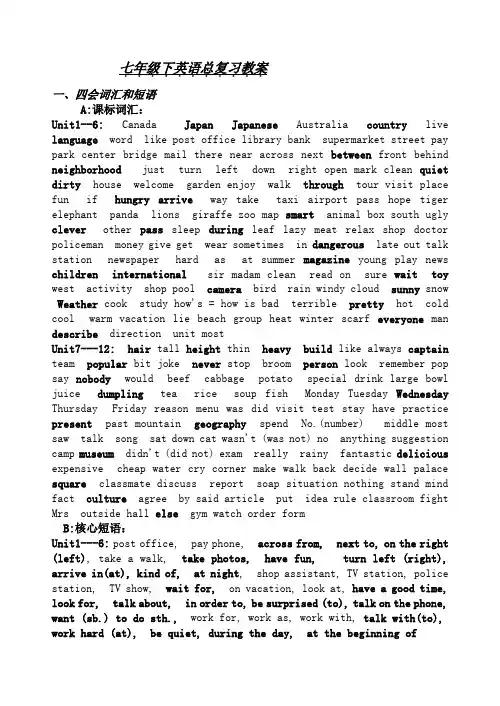
七年级下英语总复...........习教案一、四会词汇和短语A:课标词汇:Unit1--6: Canada Japan Japanese Australia country live language word like post office library bank supermarket street pay park center bridge mail there near across next between front behind neighborhood just turn left down right open mark clean quiet dirty house welcome garden enjoy walk through tour visit place fun if hungry arrive way take taxi airport pass hope tiger elephant panda lions giraffe zoo map smart animal box south ugly clever other pass sleep during leaf lazy meat relax shop doctor policeman money give get wear sometimes in dangerous late out talk station newspaper hard as at summer magazine young play news children international sir madam clean read on sure wait toy west activity shop pool camera bird rain windy cloud sunny snow Weather cook study how's = how is bad terrible pretty hot cold cool warm vacation lie beach group heat winter scarf everyone man describe direction unit mostUnit7---12: hair tall height thin heavy build like always captain team popular bit joke never stop broom person look remember pop say nobody would beef cabbage potato special drink large bowl juice dumpling tea rice soup fish Monday Tuesday Wednesday Thursday Friday reason menu was did visit test stay have practice present past mountain geography spend No.(number) middle most saw talk song sat down cat wasn't (was not) no anything suggestion camp museum didn't (did not) exam really rainy fantastic delicious expensive cheap water cry corner make walk back decide wall palace square classmate discuss report soap situation nothing stand mind fact culture agree by said article put idea rule classroom fight Mrs outside hall else gym watch order formB:核心短语:Unit1---6:post office, pay phone, across from, next to, on the right (left), take a walk, take photos, have fun, turn left (right), arrive in(at), kind of, at night, shop assistant, TV station, police station, TV show, wait for, on vacation, look at, have a good time, look for, talk about, in order to, be surprised (to), talk on the phone, want (sb.) to do sth., work for, work as, work with, talk with(to), work hard (at), be quiet, during the day, at the beginning ofUnit7---12: a little bit, stop to do sth. ( Stop doing sth.),like doing sth., go shopping,look like, would like (to) do sth., stay at home, do some reading (shopping), have a party, s tudy for the rest, go to the movies,play the guitar, play soccer(basketball), spend ...doing(on) sth., e njoy doing sth., go for a walk,have fun doing sth.,decide to do sth., talk show, soap opera, sports show, think of, tell sb. to do sth., have to, in fact,be late for二、考点分析1、look,看,①是系动词,后可跟形容词,如,look good, look sad, look worried,look beautiful;②还可以是行为动词,表动作,并能组成许多短语,如,look at(向...看),look out of(向...外看),look for(寻找),look after(照看)=take care of, look like(看起来象...)等。
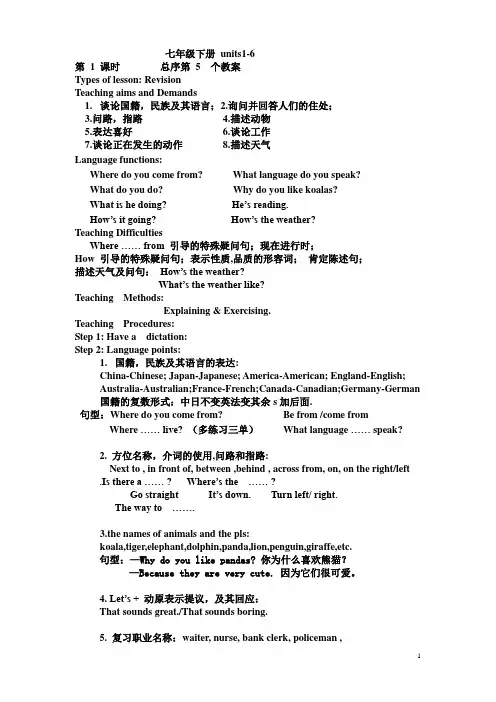
七年级下册units1-6第 1 课时总序第 5 个教案Types of lesson: RevisionTeaching aims and Demands1.谈论国籍,民族及其语言;2.询问并回答人们的住处;3.问路,指路4.描述动物5.表达喜好6.谈论工作7.谈论正在发生的动作8.描述天气Language functions:Where do you come from? What language do you speak?What do you do? Why do you like koalas?What is he doing? He’s reading.How’s it going? How’s the weather?Teaching DifficultiesWhere …… from 引导的特殊疑问句;现在进行时;How 引导的特殊疑问句;表示性质,品质的形容词;肯定陈述句;描述天气及问句:How’s the weather?What’s the weather like?Teaching Methods:Explaining & Exercising.Teaching Procedures:Step 1: Have a dictation:Step 2: Language points:1.国籍,民族及其语言的表达:China-Chinese; Japan-Japanese; America-American; England-English;Australia-Australian;France-French;Canada-Canadian;Germany-German 国籍的复数形式:中日不变英法变其余s加后面.句型:Where do you come from? Be from /come from Where …… live? (多练习三单)What language …… speak?2. 方位名称,介词的使用,问路和指路:Next to , in front of, between ,behind , across from, on, on the right/left.Is there a …… ? Where’s the …… ?Go straight It’s down. Turn left/ right.The way to …….3.the names of animals and the pls:koala,tiger,elephant,dolphin,panda,lion,penguin,giraffe,etc.句型:—Why do you like pandas? 你为什么喜欢熊猫?—Because they are very cute. 因为它们很可爱。
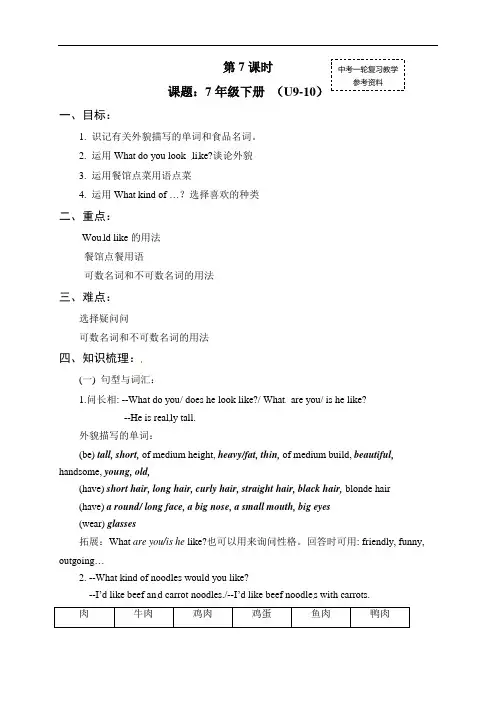
第7课时课题:7年级下册 (U9-10)一、目标:1. 识记有关外貌描写的单词和食品名词。
2. 运用What do you look li ke?谈论外貌3. 运用餐馆点菜用语点菜4. 运用What kind of …?选择喜欢的种类二、重点: Wou ld like 的用法餐馆点餐用语可数名词和不可数名词的用法三、难点:选择疑问问可数名词和不可数名词的用法四、知识梳理:(一) 句型与词汇:1.问长相: --What do you/ does he look like?/ What are you/ is he like? --He is real ly tall. 外貌描写的单词:(be) tall, short, of medium height, heavy/fat, thin, of medium build, beautiful, handsome, young, old,(have) short hair, long hair, curly hair, straight hair, black hair, blonde hair (have) a round/ long face, a big nose, a small mouth, big eyes (wear) glasses拓展:What are you/is he like?也可以用来询问性格。
回答时可用: friendly, funny, outgoing …2. --What kind of noodles would you like?--I’d like beef an d carrot noodles./--I’d like beef noodles with carrots. 肉牛肉鸡肉鸡蛋鱼肉鸭肉中考一轮复习教学参考资料meat beef chicken egg fish duck猪肉羊肉火腿蔬菜卷心菜土豆pork mutton ham vegetable cabbage potato胡萝卜西红柿洋葱面条饺子面包carrot tomato onion noodles dumpling bread蛋糕汉堡米饭汤薄煎饼粥,稀饭cake hamburger rice soup pancake porridge3.--What size would you like?--I’d like a large/ medium/ small bowl, please.4. --Would you like a large bowl?--Yes, please.(肯定回答)--No, thank you.(否定回答)5. See you later then. 回头见。
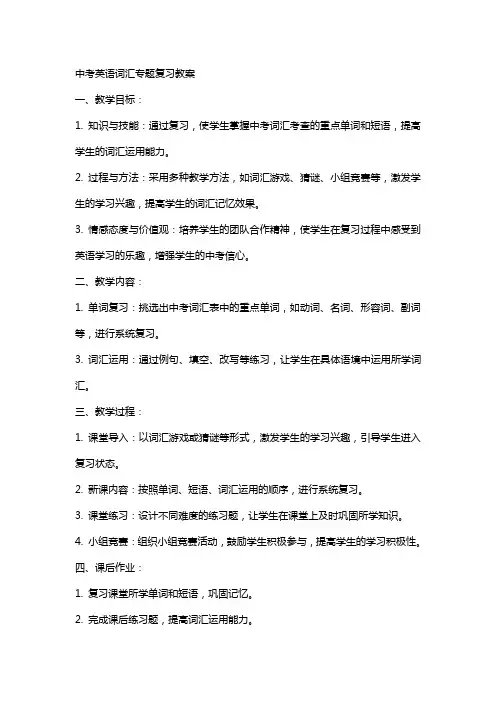
中考英语词汇专题复习教案一、教学目标:1. 知识与技能:通过复习,使学生掌握中考词汇考查的重点单词和短语,提高学生的词汇运用能力。
2. 过程与方法:采用多种教学方法,如词汇游戏、猜谜、小组竞赛等,激发学生的学习兴趣,提高学生的词汇记忆效果。
3. 情感态度与价值观:培养学生的团队合作精神,使学生在复习过程中感受到英语学习的乐趣,增强学生的中考信心。
二、教学内容:1. 单词复习:挑选出中考词汇表中的重点单词,如动词、名词、形容词、副词等,进行系统复习。
3. 词汇运用:通过例句、填空、改写等练习,让学生在具体语境中运用所学词汇。
三、教学过程:1. 课堂导入:以词汇游戏或猜谜等形式,激发学生的学习兴趣,引导学生进入复习状态。
2. 新课内容:按照单词、短语、词汇运用的顺序,进行系统复习。
3. 课堂练习:设计不同难度的练习题,让学生在课堂上及时巩固所学知识。
4. 小组竞赛:组织小组竞赛活动,鼓励学生积极参与,提高学生的学习积极性。
四、课后作业:1. 复习课堂所学单词和短语,巩固记忆。
2. 完成课后练习题,提高词汇运用能力。
3. 自主学习拓展词汇,增加词汇量。
五、教学评价:1. 课堂表现:观察学生在课堂上的参与程度、发言情况等,了解学生的学习状态。
2. 课后作业:检查学生的作业完成情况,评估学生的学习效果。
3. 单元测试:定期进行单元测试,检验学生对中考词汇的掌握程度。
4. 学生反馈:听取学生的意见和建议,不断调整教学方法,提高教学质量。
六、教学策略:1. 多样化教学:运用图片、视频、音频等多种教学资源,丰富教学手段,提高学生的学习兴趣。
2. 情境教学:创设真实的生活情境,让学生在语境中学习词汇,提高词汇的运用能力。
3. 联想记忆:引导学生运用联想记忆法,帮助学生记忆单词和短语。
4. 巩固练习:通过课后作业、课堂练习等形式,及时巩固所学知识。
5. 反馈与评价:定期进行教学反馈,了解学生的学习情况,调整教学策略。
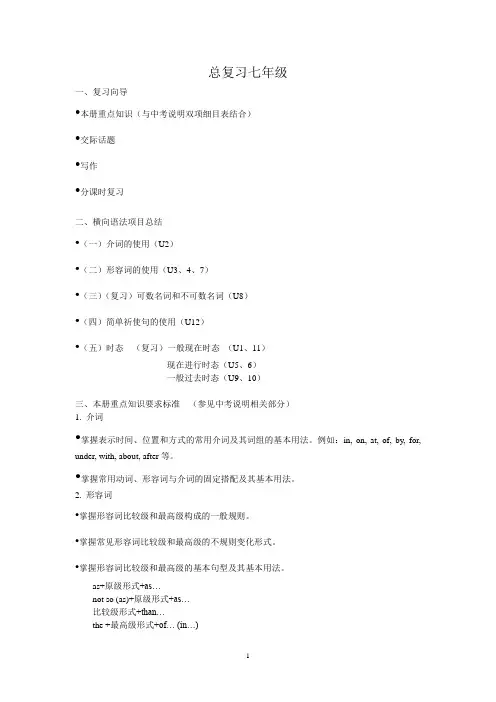
总复习七年级一、复习向导•本册重点知识(与中考说明双项细目表结合)•交际话题•写作•分课时复习二、横向语法项目总结•(一)介词的使用(U2)•(二)形容词的使用(U3、4、7)•(三)(复习)可数名词和不可数名词(U8)•(四)简单祈使句的使用(U12)•(五)时态(复习)一般现在时态(U1、11)现在进行时态(U5、6)一般过去时态(U9、10)三、本册重点知识要求标准(参见中考说明相关部分)1. 介词•掌握表示时间、位置和方式的常用介词及其词组的基本用法。
例如:in, on, at, of, by, for, under, with, about, after等。
•掌握常用动词、形容词与介词的固定搭配及其基本用法。
2. 形容词•掌握形容词比较级和最高级构成的一般规则。
•掌握常见形容词比较级和最高级的不规则变化形式。
•掌握形容词比较级和最高级的基本句型及其基本用法。
as+原级形式+as…not so (as)+原级形式+as…比较级形式+than…the +最高级形式+of… (in…)Which (Who) …+比较级形式,…or…?Which (Who) …+最高级形式,…, …or…?•掌握形容词作表语和定语的用法。
3. 时态•掌握动词的过去式、现在分词的形式。
•掌握动词现在进行时态和一般过去时态的基本结构和基本用法。
4. 祈使句•掌握祈使句的构成形式及基本用法。
5. 交际话题•问路(U2)打电话(U6)就餐(U8)四、中考说明中的写作能力要求•1. 能正确使用大小写字母和标点。
•2. 能简单描述人物、活动或事件。
•3. 写作话题与学生个人、家庭和学校生活密切相关。
•4. 学生即能表述事实,又能表达观点、情感和态度等。
•5. 能正确使用常见的连接词表示顺序和逻辑关系。
五、解读中考说明写作要求•1. 主题(写人、记事)•2. 文章结构(开头、主体、结尾)•3. 时态•4. 句式多样•5. 适当使用连词•6. 美词使用六、写作话题•个人(U1结交笔友、U7谈论朋友外表、U3、11谈论喜好、U4谈论未来职业)•家庭(U9周末活动、U10节假日活动)•学校(U12学校规则)七、写作方式•描述人物、活动或事件(U4职业、U9、10周末、节假日活动)•表达观点、情感和态度(U3、11谈论喜好等观点)八、分课时复习•一、头脑风暴(单元-标题-话题-词汇)•二、语法详解及简单练习(幻灯片形式)•三、用掌握的相关语法完成任务。
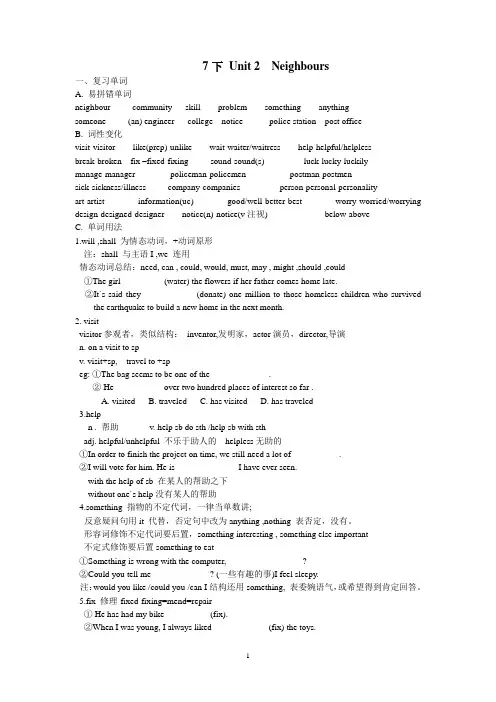
7下Unit 2 Neighbours一、复习单词A. 易拼错单词neighbour community skill problem something anythingsomeone (an) engineer college notice police station post officeB. 词性变化visit-visitor like(prep)-unlike wait-waiter/waitress help-helpful/helplessbreak-broken fix –fixed-fixing sound-sound(s) luck-lucky-luckilymanage-manager policeman-policemen postman-postmensick-sickness/illness company-companies person-personal-personalityart-artist information(uc) good/well-better-best worry-worried/worrying design-designed-designer notice(n)-notice(v注视) below-aboveC. 单词用法1.will ,shall 为情态动词,+动词原形注:shall 与主语I ,we 连用情态动词总结:need, can , could, would, must, may , might ,should ,could①The girl__________(water) the flowers if her father comes home late.②It`s said they ____________(donate) one million to those homeless children who survivedthe earthquake to build a new home in the next month.2. visitvisitor参观者,类似结构:inventor,发明家,actor演员,director,导演n. on a visit to spv. visit+sp, travel to +speg: ①The bag seems to be one of the _____________.② He ___________over two hundred places of interest so far .A. visitedB. traveledC. has visitedD. has traveled3.helpn . 帮助v. help sb do sth /help sb with sthadj. helpful/unhelpful 不乐于助人的helpless无助的①In order to finish the project on time, we still need a lot of___________.②I will vote for him. He is ______________I have ever seen.with the help of sb 在某人的帮助之下without one`s help没有某人的帮助4.something 指物的不定代词,一律当单数讲;反意疑问句用it 代替,否定句中改为anything ,nothing 表否定,没有。
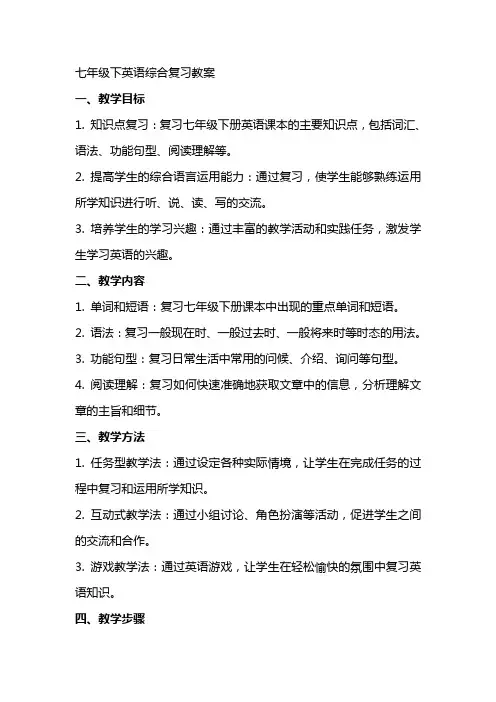
七年级下英语综合复习教案一、教学目标1. 知识点复习:复习七年级下册英语课本的主要知识点,包括词汇、语法、功能句型、阅读理解等。
2. 提高学生的综合语言运用能力:通过复习,使学生能够熟练运用所学知识进行听、说、读、写的交流。
3. 培养学生的学习兴趣:通过丰富的教学活动和实践任务,激发学生学习英语的兴趣。
二、教学内容1. 单词和短语:复习七年级下册课本中出现的重点单词和短语。
2. 语法:复习一般现在时、一般过去时、一般将来时等时态的用法。
3. 功能句型:复习日常生活中常用的问候、介绍、询问等句型。
4. 阅读理解:复习如何快速准确地获取文章中的信息,分析理解文章的主旨和细节。
三、教学方法1. 任务型教学法:通过设定各种实际情境,让学生在完成任务的过程中复习和运用所学知识。
2. 互动式教学法:通过小组讨论、角色扮演等活动,促进学生之间的交流和合作。
3. 游戏教学法:通过英语游戏,让学生在轻松愉快的氛围中复习英语知识。
四、教学步骤1. 单词和短语复习:通过闪卡、竞赛等方式复习重点单词和短语。
2. 语法复习:通过例句、练习等形式复习时态的用法。
3. 功能句型复习:通过情景模拟、对话练习等方式复习常用句型。
4. 阅读理解复习:通过阅读练习、信息匹配等形式复习阅读理解技巧。
五、作业与评价1. 作业:布置相关的练习题,让学生巩固所学知识。
2. 评价:通过课堂表现、作业完成情况、测试成绩等多种方式对学生进行综合评价。
六、教学目标1. 知识巩固:通过复习,使学生能够巩固七年级下册英语课本的主要知识点,包括词汇、语法、功能句型、阅读理解等。
2. 提升口语表达能力:通过小组讨论、角色扮演等活动,提高学生的英语口语表达能力。
七、教学内容1. 单词和短语:继续复习七年级下册课本中出现的重点单词和短语,巩固记忆。
2. 语法:通过实例和练习,进一步巩固时态、语态等语法知识。
3. 功能句型:结合情境,巩固日常生活中的常用句型,提高学生的实际应用能力。
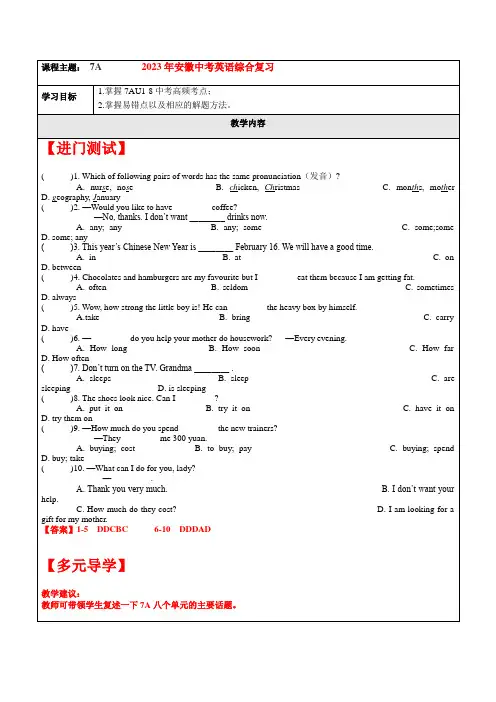
【互动精讲】中考高频考点及易错点梳理【知识梳理1】How to look after your e-dog?(1)look after意为,同义短语为。
(2)how to do sth.意为,是的结构。
【答案】(1)look after意为“照料;照顾”,同义短语为take care of。
(2)how to do sth.意为“怎样做某事”,是“特殊疑问词+to do sth.”的结构。
【例题精讲】例1. Mother is ill. I must look after her well.例2. Can you tell me how to start this computer?【课堂练习】I look after my mother well.= I my mother.【答案】take good care of【解析】look after = take care of“照顾”,look after... well = take good care of... “把......照顾的很好”。
【知识梳理2】He is good at Maths.be good at的意思是,后接作宾语。
同义短语是。
【答案】be good at的意思是“擅长于……”,后接名词、代词或动名词作宾语。
同义短语是do well in。
【例题精讲】例. Helen isn’t good at school lessons but she does well in making models.【课堂练习】1.My grandfather wasn’t good at _______ decisions when he was young.A.makingB. makeC. to makeD. made【答案】A【解析】be good at... “擅长......”,后面跟动词ing形式。
所以本题应该选A。
2.我的朋友擅长游泳。
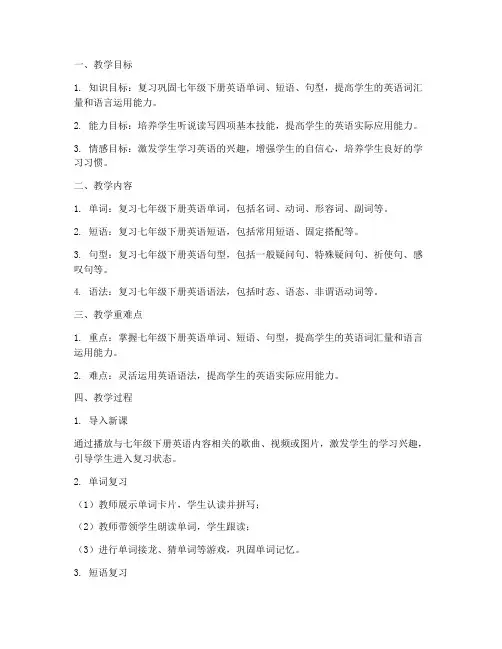
一、教学目标1. 知识目标:复习巩固七年级下册英语单词、短语、句型,提高学生的英语词汇量和语言运用能力。
2. 能力目标:培养学生听说读写四项基本技能,提高学生的英语实际应用能力。
3. 情感目标:激发学生学习英语的兴趣,增强学生的自信心,培养学生良好的学习习惯。
二、教学内容1. 单词:复习七年级下册英语单词,包括名词、动词、形容词、副词等。
2. 短语:复习七年级下册英语短语,包括常用短语、固定搭配等。
3. 句型:复习七年级下册英语句型,包括一般疑问句、特殊疑问句、祈使句、感叹句等。
4. 语法:复习七年级下册英语语法,包括时态、语态、非谓语动词等。
三、教学重难点1. 重点:掌握七年级下册英语单词、短语、句型,提高学生的英语词汇量和语言运用能力。
2. 难点:灵活运用英语语法,提高学生的英语实际应用能力。
四、教学过程1. 导入新课通过播放与七年级下册英语内容相关的歌曲、视频或图片,激发学生的学习兴趣,引导学生进入复习状态。
2. 单词复习(1)教师展示单词卡片,学生认读并拼写;(2)教师带领学生朗读单词,学生跟读;(3)进行单词接龙、猜单词等游戏,巩固单词记忆。
3. 短语复习(1)教师展示短语卡片,学生认读并拼写;(2)教师带领学生朗读短语,学生跟读;(3)进行短语接龙、猜短语等游戏,巩固短语记忆。
4. 句型复习(1)教师展示句型卡片,学生认读并翻译;(2)教师带领学生朗读句型,学生跟读;(3)进行句型接龙、猜句型等游戏,巩固句型记忆。
5. 语法复习(1)教师讲解七年级下册英语语法知识,学生认真听讲;(2)教师布置语法练习题,学生独立完成;(3)教师讲解练习题答案,学生总结归纳。
6. 综合练习(1)教师组织学生进行听、说、读、写四项技能的练习;(2)学生分组进行角色扮演、对话练习等,提高实际应用能力。
7. 课堂小结教师总结本节课所学内容,强调重点、难点,布置课后作业。
五、教学评价1. 课堂表现:观察学生在课堂上的参与度、积极性,评价学生的课堂表现。

教案Section A1.教师出示1a中的大图片,指着图片上的桌子。
T:What’s this? 叫学生猜。
帮助他们回答:It’s a table.用同样的方法教生词:bed, dresser, bookcase, sofa, chair, backpack, book, key, baseball, drawer, plant学生跟读。
2.教师指着图片T: —What’s this?—It’s a bed.让学生两人一组指着图片问答。
检查学生活动。
3.学生看着课本1a。
大声朗读单词,然后将图片中的字母番号与所给的单词配对。
检查学生完成情况。
4.让学生自己看课本1a中的图片,记忆单词。
仔细听录音(两遍),给你所听见的图中1-5样物品编号,完成1b练习。
5.教师出示2a中的单个图片,用句型:T: What’s this?T: It’s a backpack.T: What are these?T: They are keys.复习六幅图的单词。
然后仔细听录音,完成练习。
检查学生练习,完成2a练习。
6.教师创设一个询问物品方位的情景。
T: Where is my book?让学生猜,教师再运用体态表演,帮助他们回答:It’s on the desk.T: —Where is your book?—Oh, It’s in your bag.T: —Where is her book?—Aha, it’s behind the desk.用同样方法呈现介词:under, next to,教师解释其意义,让学生跟读句型。
两人一组操练以上句型。
检查学生活动。
让学生大声朗读1c中的句型两遍,画出重点句型和表示方位的介词。
7.教师用同样的方法呈现句型:T: —Where are my keys?T: —They are in my bag.T: —Where are your keys?T: —They are on the table.T: —Where are his keys?T: —They are next to the chair.让学生用自己的物品两人一组进行操练。
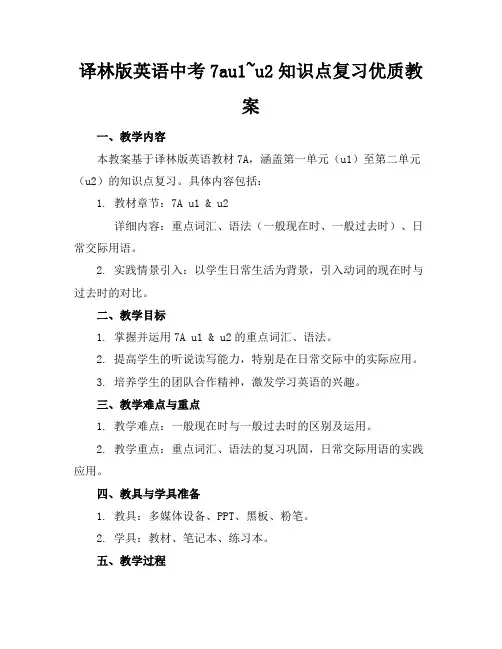
译林版英语中考7au1~u2知识点复习优质教案一、教学内容本教案基于译林版英语教材7A,涵盖第一单元(u1)至第二单元(u2)的知识点复习。
具体内容包括:1. 教材章节:7A u1 & u2详细内容:重点词汇、语法(一般现在时、一般过去时)、日常交际用语。
2. 实践情景引入:以学生日常生活为背景,引入动词的现在时与过去时的对比。
二、教学目标1. 掌握并运用7A u1 & u2的重点词汇、语法。
2. 提高学生的听说读写能力,特别是在日常交际中的实际应用。
3. 培养学生的团队合作精神,激发学习英语的兴趣。
三、教学难点与重点1. 教学难点:一般现在时与一般过去时的区别及运用。
2. 教学重点:重点词汇、语法的复习巩固,日常交际用语的实践应用。
四、教具与学具准备1. 教具:多媒体设备、PPT、黑板、粉笔。
2. 学具:教材、笔记本、练习本。
五、教学过程1. 导入:通过PPT展示学生日常生活中的图片,引导学生回顾动词的现在时与过去时。
2. 新课内容呈现:讲解一般现在时与一般过去时的区别,结合教材例句进行示范。
3. 例题讲解:讲解典型例题,强调时态的运用及语法规则。
4. 随堂练习:让学生进行小组讨论,完成练习题,巩固所学知识。
5. 小组展示:每组选代表进行成果展示,其他组进行评价。
六、板书设计1. 重点词汇:用不同颜色粉笔书写,突出重点。
2. 语法:以表格形式呈现,清晰明了。
3. 日常交际用语:用对话形式展示,便于学生模仿。
七、作业设计1. 作业题目:(1)完成课后练习题。
(2)用一般现在时与一般过去时编写一段对话。
2. 答案:课后练习题答案将在下次课上公布,学生可对照答案进行自我检查。
八、课后反思及拓展延伸1. 反思:教师应关注学生的学习进度,及时调整教学方法,提高教学效果。
2. 拓展延伸:鼓励学生利用所学知识,观察生活中的英语现象,提高英语实际应用能力。
重点和难点解析1. 教学难点:一般现在时与一般过去时的区别及运用。
中考英语词汇专题复习教案一、教学目标1. 知识与技能:通过复习,使学生掌握中考词汇表中规定的单词和短语,提高学生的词汇运用能力。
2. 过程与方法:采用多种教学手段,如词汇游戏、词组接龙等,激发学生的学习兴趣,提高学生的词汇记忆效果。
3. 情感态度与价值观:培养学生热爱英语、积极向上的学习态度,使学生在复习过程中感受到英语学习的乐趣。
二、教学内容1. 单词复习:挑选中考词汇表中的重点单词,进行循环复习,巩固记忆。
2. 短语复习:总结常考的短语,让学生通过例句理解短语的用法,并进行练习。
3. 词汇搭配:分析词汇的固定搭配,如动词+副词、形容词+名词等,提高学生的词汇搭配能力。
三、教学重点与难点1. 重点:中考词汇表中的高频单词和短语。
2. 难点:词汇的固定搭配和多义词的用法。
四、教学方法1. 采用游戏教学法,如词汇接龙、猜单词游戏等,提高学生的学习兴趣。
2. 运用情境教学法,设置真实语境,让学生在语境中学习词汇。
3. 采用分组合作学习,让学生在互动中巩固词汇。
五、教学步骤1. 热身活动:通过听力练习或口语交流,激活学生头脑中的词汇。
2. 新课导入:介绍本节课要复习的单词和短语,让学生明确学习目标。
3. 课堂讲解:讲解单词和短语的用法,分析词汇的固定搭配。
4. 练习巩固:设计不同类型的练习题,让学生在实践中运用所学词汇。
5. 总结反馈:对本节课的复习内容进行总结,查漏补缺。
6. 课后作业:布置适量的作业,让学生巩固所学词汇。
7. 教学评价:定期对学生的词汇掌握情况进行检测,了解教学效果,调整教学策略。
六、教学活动设计1. 单词记忆游戏:通过卡片游戏、拼写比赛等形式,让学生在游戏中记忆单词。
2. 短语接龙:学生分组进行短语接龙游戏,增加短语的记忆和运用。
3. 词汇搭配练习:给出词汇,让学生搭配正确的形容词、副词等,巩固词汇搭配。
4. 语境填空:提供文章或对话,让学生在语境中正确运用所学词汇。
七、教学资源1. 词汇卡片:制作单词和短语的卡片,方便学生随时复习。
七年级下英语综合复习教案一、教学目标1. 知识目标:(1)复习和巩固七年级下册英语课本的主要知识点,包括语法、词汇、功能项目等。
(2)提高学生的英语听力、口语、阅读和写作能力。
2. 能力目标:(1)培养学生运用英语进行日常交流的能力。
(2)培养学生独立阅读和理解英语文章的能力。
(3)培养学生运用英语进行写作的能力。
3. 情感目标:(1)激发学生学习英语的兴趣和积极性。
(2)培养学生的团队合作意识和竞争意识。
二、教学内容1. 复习七年级下册英语课本的主要语法点,如现在进行时、一般过去时、一般将来时等。
2. 复习和扩展课本中的重点词汇,如家庭成员、学校生活、兴趣爱好等。
3. 复习课本中的功能项目,如问路、购物、打电话等。
三、教学方法1. 采用任务型教学法,通过小组活动、角色扮演等形式,让学生在实际语境中运用英语。
2. 运用多媒体教学手段,如课件、视频等,增加课堂趣味性,提高学生的学习兴趣。
3. 采用差异化教学,关注学生的个体差异,给予不同程度的学生适当的指导和帮助。
四、教学步骤1. 热身活动:通过播放英语歌曲或进行简单的英语游戏,调动学生的学习氛围。
2. 复习语法点:通过例句和练习,让学生巩固和掌握所学的语法知识。
3. 复习词汇:通过词汇游戏、卡片等方式,让学生复习和扩展课本中的重点词汇。
4. 功能项目练习:通过角色扮演、小组活动等形式,让学生在实际语境中运用英语。
五、课后作业1. 完成课后练习册的相关题目,巩固所学知识。
2. 根据所学内容,编写一篇短文,发挥创意,展示自己的英语水平。
3. 预习下一节课的内容,准备进行课堂讨论和展示。
六、教学评价1. 课堂参与度:观察学生在课堂活动中的参与情况,了解他们的学习积极性。
2. 作业完成情况:检查学生的课后作业,评估他们对课堂所学知识的掌握程度。
3. 口语表达能力的提升:通过课堂讨论、角色扮演等活动,评估学生的口语表达能力。
4. 单元测试:定期进行单元测试,了解学生对所学知识的整体掌握情况。
译林版英语中考7au1~u2知识点复习教案一、教学内容1. 7AU1:问候与介绍、个人喜好、家庭成员、日常活动。
2. 7AU2:食物与饮料、一般现在时、一般过去时、频率副词。
二、教学目标1. 掌握问候与介绍、个人喜好、家庭成员、日常活动、食物与饮料等话题的相关词汇和句型。
2. 能够运用一般现在时和一般过去时描述人物和事件。
3. 学会使用频率副词描述日常活动。
三、教学难点与重点1. 教学难点:一般现在时和一般过去时的运用,频率副词的使用。
2. 教学重点:词汇和句型的掌握,日常对话的运用。
四、教具与学具准备1. 教具:PPT、黑板、教学卡片。
2. 学具:英语课本、练习册、笔记本。
五、教学过程1. 导入:通过PPT展示不同的问候场景,引导学生进行问候和介绍。
2. 新课内容展示:a. 通过PPT展示7AU1的词汇和句型,引导学生进行学习和练习。
b. 学生进行角色扮演,模拟真实场景进行对话。
c. 教师讲解一般现在时和一般过去时的用法,举例说明。
3. 随堂练习:a. 学生根据所给词汇和句型,编写一段自我介绍。
b. 学生分组进行角色扮演,运用一般现在时和一般过去时进行对话。
4. 例题讲解:讲解一道涉及频率副词的题目,引导学生学会使用频率副词描述日常活动。
六、板书设计1. 词汇:问候、介绍、个人喜好、家庭成员、日常活动、食物与饮料等。
2. 句型:一般现在时、一般过去时、频率副词的用法。
3. 例题:涉及频率副词的题目。
七、作业设计1. 作业题目:请运用本节课所学词汇和句型,编写一段关于自己家庭成员的介绍。
2. 答案:略。
八、课后反思及拓展延伸1. 反思:关注学生在课堂中的参与度和掌握程度,针对学生的薄弱环节进行针对性的辅导。
2. 拓展延伸:b. 学生收集关于不同国家的问候方式和日常活动的资料,进行课堂分享。
重点和难点解析1. 教学难点:一般现在时和一般过去时的运用,频率副词的使用。
2. 教学过程中的随堂练习:学生根据所给词汇和句型编写自我介绍,分组进行角色扮演。
中考英语总复习教案一、教学目标1. 知识点梳理:回顾和巩固中考英语考试范围内的重点语法、词汇、听力、阅读、写作等知识点。
2. 技能提升:提高学生的综合运用英语的能力,包括听、说、读、写四个方面。
3. 考试技巧:培养学生的应试策略,提高答题速度和准确率。
4. 心理辅导:帮助学生树立信心,调整心态,应对中考挑战。
二、教学内容1. 第六至第十单元知识点复习。
2. 重点语法点讲解与练习。
3. 词汇复习与运用。
4. 听力理解训练。
5. 阅读理解训练。
6. 写作技巧指导。
7. 模拟试题练习与讲解。
三、教学过程1. 课堂讲解:教师根据教材和复习计划,讲解重点知识点,引导学生回顾和巩固。
2. 课堂练习:教师布置针对性的练习题,学生当场完成,教师及时批改并讲解。
3. 课后作业:教师布置课后作业,要求学生巩固所学知识,提高自主学习能力。
4. 模拟考试:定期组织模拟考试,检验学生的复习效果,及时调整教学策略。
5. 心理辅导:教师与学生沟通,了解学生的心理状况,给予鼓励和支持。
四、教学评价1. 课堂参与度:观察学生在课堂上的活跃程度,参与课堂提问和讨论。
2. 练习完成情况:检查学生课后练习的完成质量,及时了解学生的学习情况。
3. 模拟考试成绩:分析学生的模拟考试成绩,评估复习效果。
4. 学生反馈:收集学生的意见和建议,不断优化教学方法和内容。
五、教学资源1. 教材:人教版《初中英语教材》。
2. 教辅资料:中考英语复习资料、模拟试题、语法点讲解等。
3. 教学设备:投影仪、电脑、黑板等。
4. 网络资源:英语学习网站、在线听力、阅读材料等。
六、教学策略1. 分类讲解:将知识点进行分类,有针对性地进行讲解,使学生更好地理解和掌握。
2. 案例分析:结合实际案例,让学生更好地理解和运用知识点。
3. 互动教学:鼓励学生积极参与课堂讨论,提高课堂氛围,提高学生的学习兴趣。
4. 小组合作:组织学生进行小组合作,互相学习,互相帮助,提高学习效果。
中考复习英语教案七篇中考复习英语教案精选篇1教学目标:1. 会说Hi和 Hello,能使用 He、Hello互相问好。
2. 会用I’m介绍自己。
3. 激发学生学习英语的兴趣,并能在相应的场景中自如地表演运用。
教学准备:Recorder and tape教学过程:Step 1 Introduction1.师生问候;(师说英语,用手势示意,上课,起立,坐下。
)2.简介英语的重要性,激发学生学习热情,鼓励学生学好英语。
Step 2 PresentationTeaching ‘Hi’ and ‘Hello’1. 师用Hi、 Hello与学生问好,鼓励学生大胆回答,适当纠正学生的读音。
对学生及时给予表扬。
2. 让学生用Hi、 Hello自由问好。
Step 3 PresentationTeaching ‘ I’m…。
’1. 师先用中文介绍自己,再用英文说I’m Miss Jiang,放慢语速反复多次。
2. 鼓励学生用I’m…。
介绍自己。
(每个学生说完,全班给予掌声鼓励)Step 4 Practice1. 师用Hi/Hello, I’m Miss Jiang. 与学生问好,引导学生用 Hi/Hello, I’m …作答。
2. 学生分组用Hi/Hello, I’m 互相自我介绍。
3. 唱《找朋友》,让学生下位用“Hi/Hello, I’m”找朋友。
4. 指名上台表演。
5. 引导学生展开想象,让他们在类似的生活场景中运用所学语言。
T: Hello ,I am Miss Jiang .S: Hello ,I am Mike .Step 5 Act用Hi/Hello,I’m…。
Goodbye /Bye向全班同学介绍自己。
Step 7 Homework回家用所学的句型与父母问好、道别。
Some thoughts after the lesson:教学反思:整堂课上下来,还是觉得有的环节之间过渡的不是很自然,教学形式还可以丰富一些,使课堂气氛更加活跃,同时在课堂纪律方面也要加强管理。
七年级下复习教案
大单元教学设计一,单元内容分析(课标分析)
二,单元教学目标
三,学情分析
总复习阶段,学生的态度总体较为积极。
绝大多数学生对英语总复习持有较高的兴趣和主动学习态度。
他们愿意参与课堂活动,并愿意主动与教师和同学进行交流。
然而,也有一部分学生对英语复习缺乏热情,需要教师的教育和激励,大部分学生的英语整体水平较为均衡。
大多数学生能够熟练掌握基本的英语语法和词汇,并能够进行简单的听说读写。
然而,仍有一部分学生的英语水平相对较低,需要额外的支持和指导。
四,教学要点和课时安排
单元分课时设计
单元分课时设计
单元分课时设计。
Book 2 (7年级下) 复习一、复习向导•单元知识体系表(单元、主题、语法项目)•本册重点知识(与中考说明双项细目表结合)•交际话题•写作•分课时复习二、单元知识体系表三、横向语法项目总结•(一)介词的使用(U2)•(二)形容词的使用(U3、4、7)•(三)(复习)可数名词和不可数名词(U8)•(五)时态(复习)一般现在时态(U1、11)现在进行时态(U5、6)一般过去时态(U9、10)四、本册重点知识要求标准(参见中考说明相关部分)1. 介词•掌握表示时间、位置和方式的常用介词及其词组的基本用法。
例如:in, on, at, of, by, for, under, with, about, after等。
•掌握常用动词、形容词与介词的固定搭配及其基本用法。
2. 形容词•掌握形容词比较级和最高级构成的一般规则。
•掌握常见形容词比较级和最高级的不规则变化形式。
•掌握形容词比较级和最高级的基本句型及其基本用法。
as+原级形式+as…not so (as)+原级形式+as…比较级形式+than…the +最高级形式+of… (in…)Which (Who) …+比较级形式,…or…?Which (Who) …+最高级形式,…, …or…?•掌握形容词作表语和定语的用法。
3. 时态•掌握动词的过去式、现在分词的形式。
•掌握动词现在进行时态和一般过去时态的基本结构和基本用法。
4. 祈使句•掌握祈使句的构成形式及基本用法。
5. 交际话题•问路(U2)打电话(U6)就餐(U8)五、中考说明中的写作能力要求•1. 能正确使用大小写字母和标点。
•3. 写作话题与学生个人、家庭和学校生活密切相关。
•4. 学生即能表述事实,又能表达观点、情感和态度等。
•5. 能正确使用常见的连接词表示顺序和逻辑关系。
六、解读中考说明写作要求•1. 主题(写人、记事)•2. 文章结构(开头、主体、结尾)•3. 时态•4. 句式多样•5. 适当使用连词•6. 美词使用七、写作话题•个人(U1结交笔友、U7谈论朋友外表、U3、11谈论喜好、U4谈论未来职业)•家庭(U9周末活动、U10节假日活动)•学校(U12学校规则)八、写作方式•描述人物、活动或事件(U4职业、U9、10周末、节假日活动)•表达观点、情感和态度(U3、11谈论喜好等观点)九、分课时复习•一、头脑风暴(单元-标题-话题-词汇)•二、语法详解及简单练习(幻灯片形式)•三、用掌握的相关语法完成任务。
•四、巩固练习(卷子形式)Period 1 (Review Unit 1, 2)Brainstorming (U1 Where’s your pen pal from?、Unit 2 Where’s the post office? ) •Topic:•V ocabulary: countries, cities, languages•Key sentences:介词的用法介词练习(幻灯片)1. What time did you get there this morning? _______ eight. (‘03北京)A. InB. OnC. AtD. From2. Who’s the man _______ black?He’s Mr. White. (‘03宁波)A. inB. withC. onD. of3. How are you going to the train station to meet your aunt? I’m going there _______ my car. (‘03河北)A. byB. inC. toD. on4. You should make a good plan ___ you do anything important. (‘04南通)A. beforeB. afterC. thoughD. until5. We are now short _____ fresh water. Something must be done to stop people _____ polluting it. (‘04南通)A. for, toB. for, fromC. of, toD. of, from6. It was a very long day for Jack. He didn’t get home from school __ six o’clock. (‘04杭州)A. sinceB. toC. byD. until7. Gina was born ____ 1999. She is old enough to go to school. (‘06海淀)A. toB. onC. atD. in8. When do you usually get up every day?___ about 6:00 a.m. (‘06吉林)A. AtB. OnC. InD. For9. Who will be ___ duty tomorrow? Susan will.A. atB. onC. forD. in10. After class, I like playing computer games and chatting ____ my friends ___ the Internet.A. to; byB. with; onC. for; inD. about; throughTask:Can you tell me the way to …?•Your pen pal is visiting you. He wants to buy some stamps. Please make a conversation with himto tell him the place he can go to.Period 2 Review Unit 3, 4, 7Brainstorming (Unit 3 Why do you like koalas? Unit 4 I want to be an actor.Unit 7 What does he look like? )•Topic:•V ocabulary: animals, description words•Key sentences:形容词的用法•规则形容词的比较级和最高级构成:•单音节词尾+er / est few-fewer-fewest•以e结尾词尾+r / st nice-nicer-nicest•以辅音字母+y结尾,变y为i+er / est busy-busier-busiest•以重读闭音节结尾的,双写最后字母+er / est fat-fatter-fattest•多音节和部分双音节词,前面+more / most popular-more popular-most popular •少数词有两种变化:friendly, clever, simple•不规则变化•good-better-best well-better-best•ill-worse-worst bad / badly-worse-worst many-more-most little-less-least far-farther-farthest far-further-further形容词变副词•许多形容词词尾+ly变为副词;如果形容词以辅音+y结尾,要变y为i后+ly quick-quickly usual-usually heavy-heavily easy-easily …•有些词虽然以ly结尾,但它们是形容词friendly, ugly, lovely形容词原级、比较级、最高级句型as+原级形式+as…not so (as)+原级形式+as…比较级形式+than…the +最高级形式+of… (in…)Which (Who) …+比较级形式,…or…?Which (Who) …+最高级形式,…, …or…?三个特殊句型•比较级+and+比较级:越来越…Our life is becoming better and better.•the+比较级,the+比较级:越…,越…The more you eat, the heavier you will be.•one of+最高级+名词复数:最…之一Jack is one of the best students in the school.形容词在句中的位置•一般放在所修饰的名词前a pretty girl•放在所修饰的复合不定代词后nothing wrong•放在表示数量词组后twelve meters long•放在be动词或系动词后The flowers smell nice.形容词练习•1. An elephant is ____ than a tiger.A. heavyB. very heavyC. the heaviestD. heavier •2. I am __. I want a piece of bread.A. fullB. hungryC. tiredD. thirsty •3. Remember this, children. ___ careful you are, __ mistakes you will make.A. The more; the moreB. The fewer; the moreC. The less; the lessD. The more; the fewer4. Will you please drive _______? The train is leaving soon. (‘05长春)A. quickB. fasterC. slowlyD. more slowly5. Kate is really _______. She’s never angry with others. (‘05安徽)A. tallB. friendlyC. luckyD. clever6. I’m fourteen. My friend is sixteen. So I’m _______ him. (‘05济南)A. as old asB. not younger thanC. not so young asD. two years younger than7. I think Alice is the right person for the job, because she’s always thinking ____ of others than of herself. (‘06安徽)A. muchB. moreC. littleD. less8. Is your toothache getting better? No, it’s _____. (‘06江西)A. badB. seriousC. worseD. the worst9. This year our school is ___ than it was last year. (‘06陕西)A. much more beautifulB. much beautifulC. the most beautifulD. beautifulTask:My favorite animal (job, friend) is….•Please tell us your ideas according to one of the pictures with some description words.Period 3 Review Unit 5,6,9,10Brainstorming (Unit 5 I’m watching TV.Unit 6 It’s raining!Unit 9 How was your weekend? Unit 10 Where did you go on vacation? ) Topic:•Vocabulary:•Key sentences:动词时态现在进行时态:含义:表示说话时正在发生的动作结构:be(am;is;are)+doing常与now;at present及Look!;Listen!连用例:He is doing his homework. 他正在做作业。